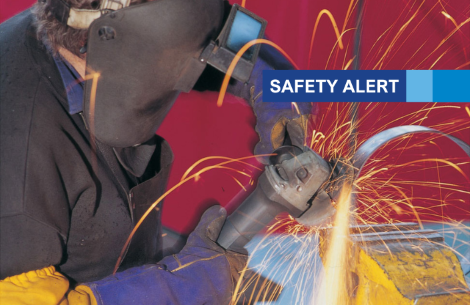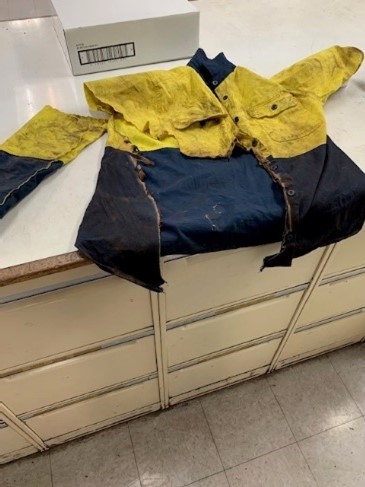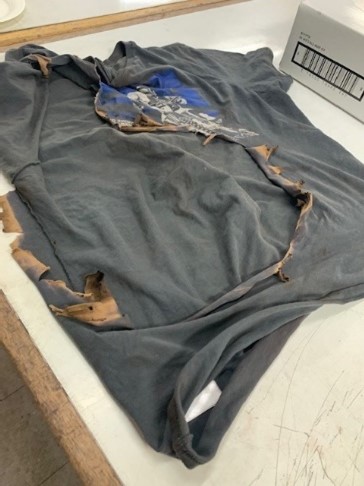
26 June 2023
Serious burns to a worker after his shirt caught fire was among 23 incidents involving angle grinders reported to SafeWork SA this financial year.
The data has prompted SafeWork SA to highlight the serious dangers of using angle grinders without appropriate controls in place.
Angle grinders are extremely powerful tools and have the potential to cause serious injury or fatalities.
Flying debris from the material being cut can result in severe lacerations. Sparks caused by grinding can ignite fires.
Discs can disintegrate, releasing fragments that can damage the operators’ eyes or body.
A review of SafeWork SA’s compliance database has identified 23 notifiable incidents this financial year.
In an incident in December, a worker who was not wearing appropriate PPE while using an angle grinder, suffered serious burns when airborne sparks caused his shirt to catch fire.
The worker spent six days in the Royal Adelaide Hospital Burns Unit, receiving treatment for serious burns to his chest, back and arm.


The worker's burnt clothing.
Other serious angle grinder incidents throughout the year include:
- Nine incidents resulting in serious lacerations, caused by material not being secured before being cut.
- Three incidents resulting in serious lacerations, caused by the angle grinder kicking back onto the operator.
- An operator was exposed to asbestos fibres after grinding a gasket that contained asbestos material.
- An operator sustained eye and facial injuries when a grinding disk shattered during use.
- Grinding sparks caused a grass fire.
- Seven electric shocks.
Controlling the risk
Businesses and workers must ensure safe systems of work are developed, implemented, and maintained to minimise the risks associated with angle grinders.
Elimination of the hazards or substitution with safer equipment should always be the first option, particularly when a safer alternative cutting tool is available.
Risk control measures could include:
- Providing operators with training and instruction in safe work procedures for angle grinders.
- Providing one on one supervision for workers receiving training in the use of angle grinders or people who are unfamiliar with their use.
- Conducting an assessment to ensure that the PPE is appropriate for the task being undertaken.
- Using the angle grinder with the correct guard supplied by the manufacturer.
- Ensuring the guard is adjusted to direct sparks away from the body to ensure the health and safety of workers and other persons or use welding screens to stop other workers being hit by flying particles and sparks.
- Fitting the correct size cutting disc that has a hole matching the spindle flange.
- Using the tightening tool supplied by the grinder manufacturer to tighten the disc. The use of another tool (such as a punch and hammer) can damage the disc and grinder.
- Holding the angle grinder with both hands ensuring the side handle is inserted on the side of the unit that gives the best grip for the work activity.
- Using the correct disc for the task. Grinding with a cutting disc for example, can damage the disc and increases the likelihood of the disc shattering during use.
- Ensuring the maximum RPM disc speed marked on the disc is higher than the maximum speed of the angle grinder.
- Ensuring damaged discs are disposed and not re-used.
- Allowing the grinder to run to speed before cutting or grinding.
- Using the correct spindle flange and lock nut for the disc and make sure these are fitted the way the angle grinder manufacturer shows in the instruction manual. The type of flange or fitting method may vary for cutting and grinding discs. If the incorrect flange and lock nut combination are used, the disc can be damaged and lead to premature failure.
- Ensuring the material being cut is secured.
- Ensuring the angel grinder has been electrically tested and inspected for damage prior to use.
- During the fire danger season, do not operate an angle grinder or other mechanical grinding tool in the open air unless you:
- On a total fire ban day, do not operate an angle grinder or other mechanical grinding tool in the open air unless you have a Schedule 10 Permit from your local council. These permits are generally only issued for emergency purposes.
- Have a 10-metre cleared space around the area, and water or an appropriate extinguisher is at hand.
- A person able to control the device is present at all times while the activity is being undertaken.
- On a total fire ban day, do not operate an angle grinder or other mechanical grinding tool in the open air unless you have a Schedule 10 Permit from your local council. These permits are generally only issued for emergency purposes.
Further links
- Angle Grinders
- How to manage work health and safety risks – code of practice
- Managing the risks of plant in the workplace – code of practice
- CFS FACT SHEET: Restrictions: What can and can’t I do?
·




